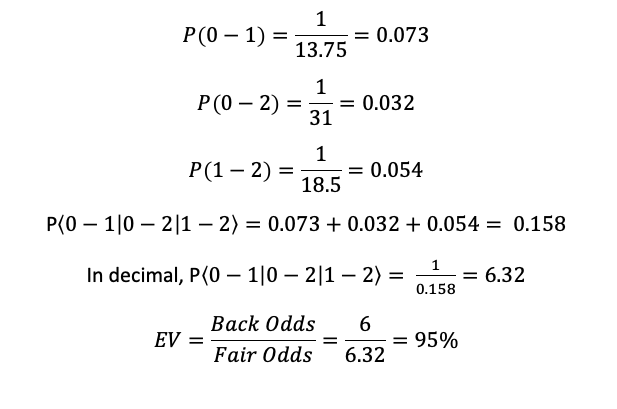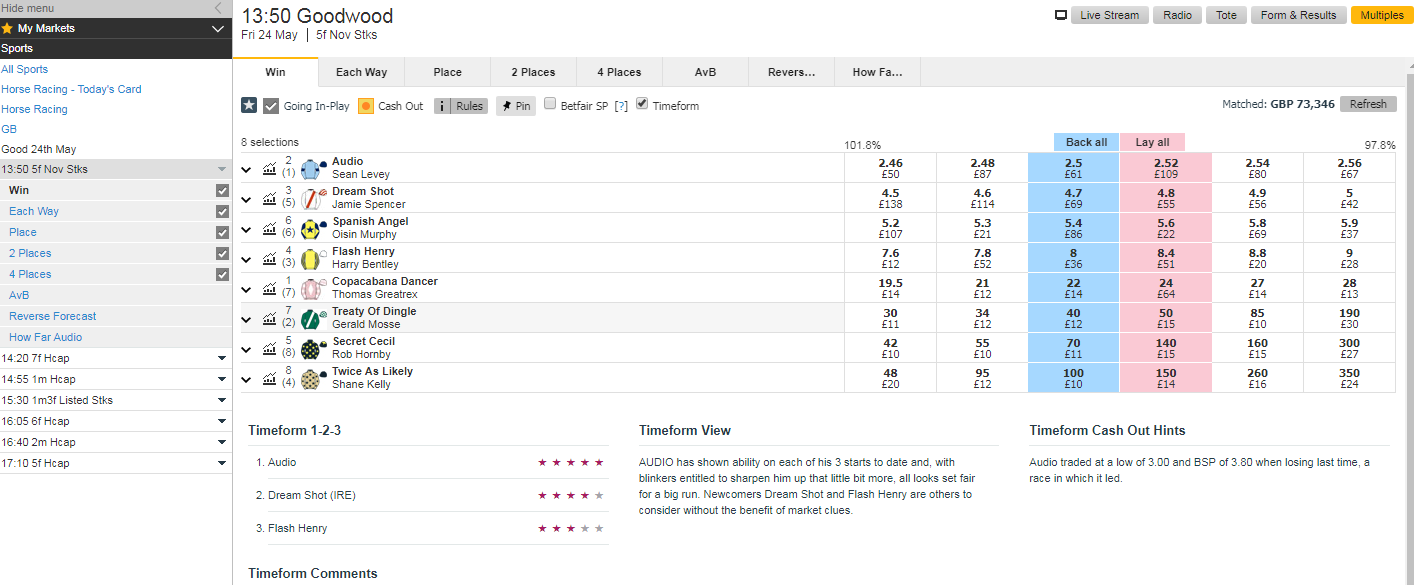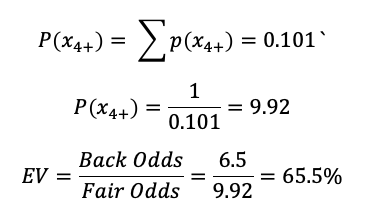Benchmarking
The first volume of this blog can be found here. In this 2nd volume we look at methods for estimating:
1. Personalised bets (eg #YourOdds)
2. Non-exclusive OR bets
3. x winners in y events
4. Exclusive OR bets
5. Team to win and over 1 or 2 goals
Mutually exclusive outcomes are outcomes that have no relationship with each other. Non-mutually exclusive outcomes do have a relationship with each other.
EG Federer to win Wimbledon or Ian Poulter to win the Open = mutually exclusive OR bet
EG Salah or Firmino to be the first goalscorer for Liverpool = non-mutually exclusive OR bet
1. Personalised bets (e.g. #YourOdds)
Personalised bets (which I’ll call #YourOdds from here on, the terminology of William Hill reads much better) consist of bets built up by multiple match variables such as goals, corners and cards. They go by alternative names depending on the bookmaker; betbuilder (bet365), oddsonthat (BFSB), pickyourpunt (Betfred), PriceItUp (Betvictor), YourCall (Coral), GetAPrice (Ladbrokes) and Requestabet (Skybet).
The service is not available on every game, and the available variables may be limited on secondary games. You can choose to create your own bets, however Bookmakers will also often offer a pre-defined list of #YourOdds. Below is a screenshot of the #YourOdds offered by William Hill for Caen vs Bordeaux.
William Hill (and all other bookmakers) tend to offer the same pre-defined #YourOdds for each match. There is a perception by bookmakers that these bets are difficult-to-impossible for punters to work out because they cannot be benchmarked against an exchange market.
The bookmakers create these bets using a discrete probability distribution. Each variable (goals, corners, cards) can be estimated for an expected total for each match, team and half. By using a probability distribution model, the bookmakers can estimate the odds of over/under x variables based on their expected average.
Helpfully we can use exactly the same model to estimate the prices ourselves and to work out if the bookmakers are offering any value. 95%+ of the pre-defined bets they offer are negative EV. However the bookies tend to estimate a pre-defined set of odds early in the day, apply a mark-up, and leave those bets up all day. They are susceptible to changing information throughout the day, and are often guilty of cutting odds late.
As always, we can take advantage of this latency.
To estimate the value in these bets we need to benchmark against the average expected goals, corners and cards for a match. To do this we can use a spread betting site. There are two main spread betting sites: SportingIndex and Spreadex. The screenshot below shows an example of the Caen vs Bordeaux match from the SportingIndex site.
The spreads offer a buy line and a sell line. We have the option of using a midpoint, or the sell or buy lines depending on the purpose of our analysis. When looking for value bets it is useful to be pessimistic. With this strategy we would use the sell line for Overs bets, and the Buy line for Under Bets. In the above example, SportingIndex offer a Buy line at 9 and a Sell line at 9.5 for the total corners in the match. For looking at any over Corners we would use a prediction of 9, and for Under corners we would use 9.5.
We have a Bet Builder calculator that accessed here. By populating the expected lines for the Caen vs Bordeaux match, we can work out the value of each #YourOdds.
By iteratively going through each one of the pre-defined #YourOdds offered by William Hill, we can estimate the lay and the Expected Value (EV) of each bet, and can then rank the bets by EV:
There are a significant number of permutations of #YourOdds which can make the process of identifying the Expected Value of each one tedious. We have a scraping model at bookiebashing that can automatically import and calculate the value, and we publish all bets > 105% EV for bet recommendation.
Additional points:
- Spread sites differ from exchanges in that the lines are set by the sites themselves, not the power of the wisdom of the crowds. Spread lines are not as accurate as exchanges because they are susceptible to the weight of money; if one side of a line is bet on predominantly then the spread site will change that line. The line is only indicative of the value the spread site is able to offer, not a fair prediction. This characteristic is balanced by the fact that a weight of money also contains sharp information, as well as the fact that over time any discrepancy on one side of the line will be balanced by discrepancies on the other. For a long-term tool to benchmark bets over hundreds of matches, the inaccuracies will balance out.
- The two big Spread sites may have different perspectives for games and may offer slightly different lines. They will never be vastly different for fear of getting smashed by spread betting arbitrage players. Where the 2 different lines are different, the best option we can use is to take an average of the midpoints.
- #YourOdds are often associated with cards instead of booking points. Cards are issued at a rate of 1 per Yellow and 2 per red. Booking points are issued at a rate of 10 points per yellow and 25 per red. Booking points are not appropriate for linear Poisson modelling due to the fact that the scoring scale is not incremental. Cards are appropriate, but are not set by the Spreads. Therefore it is first necessary to make an assumption to convert estimated booking points into cards. We have incorporated this into the model at bookiebashing through a heuristic analysis of the cards issued in all UK league games between 2012 and 2018 and use a conversion factor of 0.97 BP -> Cards.
2. Non-mutually exclusive OR Bets
William Hill enhance a bet – Union Berlin to win 1-0, 2-0 or 2-1 to 5/1.
These are three non-mutually exclusive outcomes; by that we mean only one outcome can occur. To work out the probability of one of these three events occurring we add together the probabilities.
To estimate the probability p(x) of each score we can use the exchange:
We can use the midpoint between the gap and the lay of each score 0-1, 0-2 or 1-2 to approximate the odds of P(0-1 | 0-2 | 1-2)
3. x winners in y events
Skybet offer odds of 9/2 for 4 or more winning favourites at Goodwood.
To work out if this is value, we need to document the current exchange odds of all favourites at Goodwood:
To work out the probability of x winners in these y events, we need to split up the permutations of all events. Since the bets can either win or lose, we have 2 outcomes for each of 7 events.
From this table, we can isolate all permutations with four or more winners, and add together the probabilities of each to provide us with the odds of four or more winners.
The number of permutations can make this type of calculation lengthy. We have a calculator on the bet tracker that does this for you and tracks it live.
4. Mutually exclusive OR bets
RedArmyBet have Federer to win Wimbledon or Hamilton to win the Monaco GP at 11/2.
- Federer to win Wimbledon is 10.5. In probability, this equals 1/10.5 = p(0.095)
- Hamilton to win the Monaco Grand Prix is 12.0. In probability, this equals 1/12 = p(0.083)
The calculation for a mutually exclusive OR bet is different to a non-mutually exclusive OR bet due to the fact that with a non-mutually exclusive OR bet only a single event can occur. With mutually exclusive OR bets we need to factor in to the calculation the fact that both can occur. The calculation is different depending on the number of attributes to be considered, however it keeps the same structure. For 2 events:
2 events
The equation grows with 3 or more events to account for the fact that the chances of one of the events occurring grows with every additional variable.
3 events
4 events
Things start to get messy/lengthy at 5 events and higher, however the syntax is exactly the same as we add more events. The mutually exclusive OR probability is equal to the sum of all permutations of n-1 subtracted from the sum of the probability of all n, added to the compound of probabilities of all n.
Notes
It can sometimes be difficult to identify a mutually exclusive OR bet. For example:
- Federer to win Wimbledon OR Hamilton to win the Monaco GP are mutually exclusive because the outcome of one has no relational bearing on the probability of the outcome of the other.
However:
- Federer to win Wimbledon OR Federer to win the US Open may appear as mutually exclusive however the odds of Roger winning the US Open may change depending on his success at Wimbledon. In fact, the odds of Federer winning the US Open contain a weighted average of the differences of the outcome of Federer to win the US Open if he either wins or doesn’t win Wimbledon.
- Similarly, Federer to win Wimbledon OR Djokovic to win the US Open is partially exclusive. Whilst the odds of Djokovic winning the US Open shouldn’t change much depending on whether Federer won Wimbledon or not, the fact that Federer’s Wimbledon success will have an effect on his US Open odds means there is also correlation with Djokovic’s US Open success – therefore the bets are not mutually exclusive.
5. Team to win and over 1 or 2 goals multiples
William Hill offer a bet: – Liverpool, Ross County, Leverkusen and Lyon all to win and all 4 matches over 1 goal at 12/1.
A team to win and over 1 goal is equal in probability to the chance of a team winning without the 1-0 scoreline.
P(team to win and over 1 goal) = P(team to win match) – P(team to win 1-0).
We use the exchange to determine the available lay prices and we can see that Liverpool are 1.4 to win the match and 10.5 to win 1-0.
1.4 = p(0.71)
10.5 = p(0.095)
P(Liverpool to win and over 1 goal) = 0.71 – 0.095 = 0.615.
In decimal , the odds of Liverpool winning the match and the game having over 1 goal is equal to 1/0.615 = 1.62. We can execute this calculation for all four teams above and take the multiple to estimate the Expected Value of the bet:
The calculation for a team to win and over 2 goals is similar, however we need to subtract both 1-0 and 2-0 from the probability of the team winning.





















